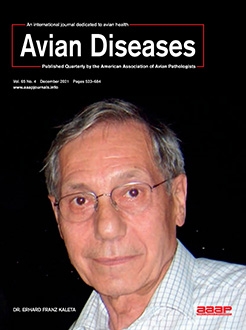West Nile virus (WNV) has been implicated in regional declines of numerous North American bird species, although its potential impact upon many species, including some game birds, remains unknown. Specifically, information about susceptibility to infection and infection outcome are crucial to assessing health risks. Northern bobwhite quail (Colinus virginianus) are a popular and common game bird across much of the United States, as well as in captive breeding programs and as backyard birds. Two age groups of bobwhites were subcutaneously inoculated with WNV and euthanatized on 15 days postinoculation (DPI). Three of 10 inoculated 5-wk-old and 4/10 inoculated 15-wk-old birds developed detectable viremia titers during 1–5 DPI, with low peak titers (101.7–103.0 plaque-forming units [PFU]/ml). Three of 10 inoculated 5-wk-old and 1/10 inoculated 15-wk-old birds shed low viral titers (peak 100.7–101.8 PFU/swab) either orally or cloacally or both for limited periods from 2 to 6 DPI. All inoculated birds (n = 20) remained apparently healthy and seroconverted by 15 DPI. No infectious virus was detected in select tissues: heart, kidney, brain, skeletal muscle, spleen (15-wk-old group only), and feathers from any of the bobwhites. No sham-inoculated, contact control birds (n = 8) became viremic or had virus isolated from tissues or swabs. The most consistent microscopic lesion was minimal to mild, lymphoplasmacytic myocarditis (6/10 in 5-wk-olds; 5/10 in 15-wk-olds). Immunohistochemical labeling was most often in macrophages in spleen and bone marrow, likely reflective of clearance of infection. There were no statistically significant differences in the peak viremia and shedding titers between age groups and no differences in the development of WNV-associated lesions between the two age groups. These results suggest that WNV is unlikely to pose a health risk to bobwhites and that bobwhites likely are an incompetent reservoir host species in WNV transmission.
How to translate text using browser tools
14 October 2021
Experimental West Nile Virus Infection in Northern Bobwhite Quail (Colinus virginianus)
Melanie R. Kunkel,
Daniel G. Mead,
Roy D. Berghaus,
Kayla G. Adcock,
Mark G. Ruder,
Nicole M. Nemeth
ACCESS THE FULL ARTICLE

Avian Diseases
Vol. 65 • No. 4
December 2021
Vol. 65 • No. 4
December 2021
Colinus virginianus
experimental infection
game bird
histopathology
immunohistochemistry
Northern bobwhite quail
viremia




